Montauk Is More Popular Than Ever — Here's How You Can Still Spend a Quiet Weekend
How my family found a quiet slice of one of the East Coast's most popular summer destinations.
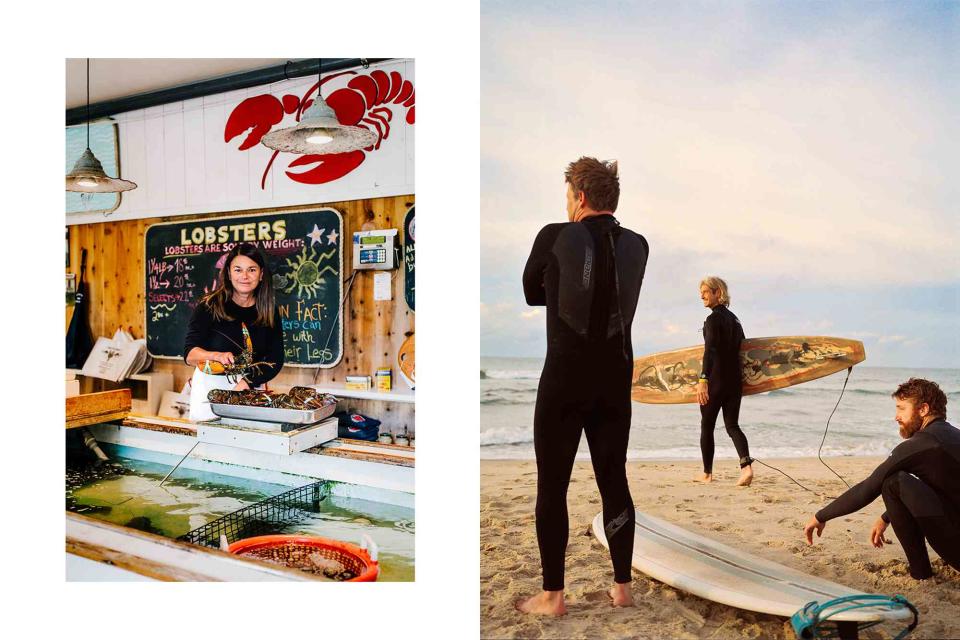
Justin Kaneps
From left: Fresh seafood for sale at Gosman's; surfers gather at Montauk's Ditch Plains on early summer mornings.
It was an oppressively hot afternoon in late August when I arrived in Montauk with my husband and our one-year-old son. The baby was grumpy and restless, tired of being strapped into his car seat and no longer sated by snacks or distractions. We had just concluded a three-hour drive from Brooklyn, the last third of which was spent sitting in Hamptons traffic, through which my husband and I stared silently at the cars ahead. We barely registered the giant houses with their perfectly manicured lawns and white picket fences; instead we prayed our child would keep napping for a little bit longer.
Finally we pulled in to the parking lot of Marram Montauk, a 1960s motel that was transformed into a chic beachside resort in 2019. The dunes in the courtyard were planted with the tall marram grass that gives the hotel its name, and the cedar paneling on the building’s exterior had already acquired a gentle patina from the salt air. Seagulls circled overhead. The air was a few degrees cooler than it was in the city, yet the sun felt gloriously warm.
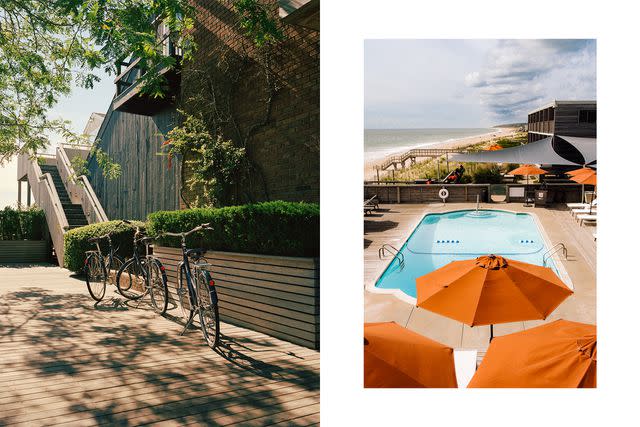
Justin Kaneps
From left: Loaner bikes at Gurney's Montauk Resort & Seawater Spa; the swimming pool at Marram Montauk.We checked in quickly and dumped our bags on the floor of our ocean-facing room before changing into our swimsuits and walking just a few paces down to the beach, where an attendant set us up with umbrellas and towels. The stifling humidity of the city was all but forgotten as I plunged into the ocean for the first time that summer. Our son, shaded by the wide umbrella, played happily in the sand. “There’s nothing better than this,” my husband said.
"While Montauk has become yet another weekend destination for New York City’s wealthy, it continues to appeal to those who are decidedly not — thanks mainly to its bayside campgrounds and beloved beachfront motels. Most importantly, it still manages to feel raw and unspoiled."
We first visited Montauk at the start of the pandemic, when we spent three glorious summer months at a friend’s house. The hamlet has a permanent population of around 4,000, though that number swells to almost 40,000 in summer. The name is derived from Montaukett, the Algonquian-speaking community that once lived on the land (today, almost none of their descendants remain in New York State).
I liked the easy simplicity of the place, the fact that there was not too much to do, no Cartier or Hermès boutiques (at least not yet) on Main Street. While Montauk has become yet another weekend destination for New York City’s wealthy, it continues to appeal to those who are decidedly not — thanks mainly to its bayside campgrounds and beloved beachfront motels. Most importantly, it still manages to feel raw and unspoiled.
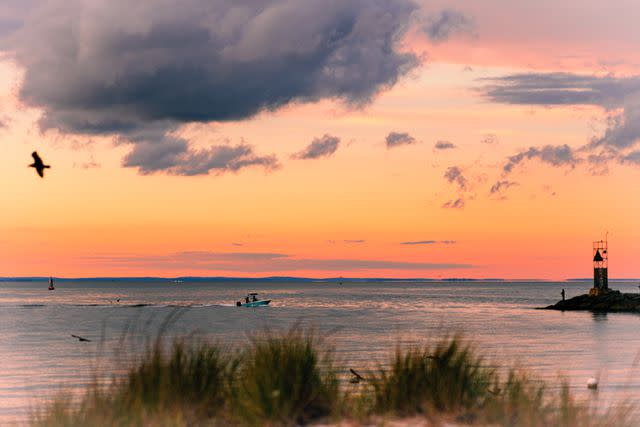
Justin Kaneps
Sunset over Montauk, as seen from the dunes near Gin Beach.I was also intrigued by its cultural history. Montauk was a haven for artists in the late 1960s and '70s. Notable residents included the playwright Edward Albee, who bought a house along the old Montauk Highway; the wildlife photographer Peter Beard, who lived in a two-story shingled house on moorland bluffs; and Andy Warhol, who, with his business partner and collaborator Paul Morrissey, purchased a sprawling compound where he invited the Rolling Stones, Halston, Liza Minnelli, Elizabeth Taylor, Jacqueline Onassis, Lee Radziwill, and others to stay.
Montauk was even the inspiration for, and the name of, a slender novel by the Swiss writer Max Frisch, who went there for a weekend in 1974. At the time, Frisch was in his early sixties and embarking on a love affair with a younger woman named Alice Locke-Carey, which he documented in the book.
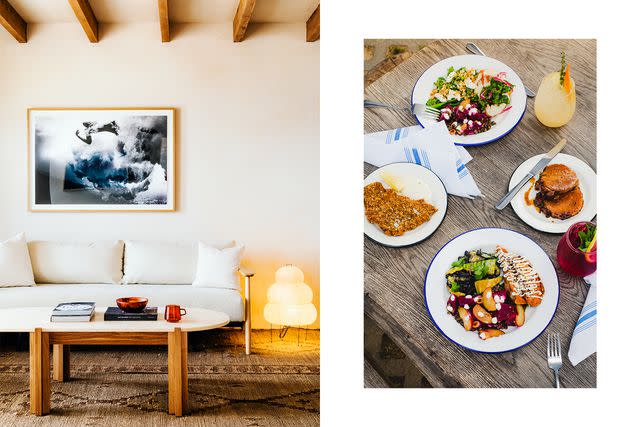
Justin Kaneps
From left: Airy interiors at Montauk Marram, a recently converted 1960s motel; a lunch spread from the hotel's Mostrador restaurant.Interspersed throughout are unsentimental descriptions of Montauk, such as when Frisch’s protagonist first explores the parklands on the outer limits of the town. “In places where the undergrowth thins, the surrounding countryside can be seen: it does not look strange to him, though he has never been here before,” Frisch wrote. “It is not Greece — different vegetation entirely. All the same, he thinks of Greece, then again of the island of Sylt.”
I understood what Frisch was getting at. In its strange wildness, Montauk manages to conjure other parts of the world. During the 17th, 18th, and 19th centuries, while farming and fishing villages were being established elsewhere on Long Island, much of Montauk remained an open range for grazing livestock — for almost as long, only three houses stood on its 9,000 acres of pasture. Development didn’t really start until the 1920s; tourists came in the 50s and 60s, with the arrival of motels and campsites. Perhaps the fact that this land was untamed for so long explains why people continue to retreat here, and come here to be left alone.
Because the hamlet rests on the very tip of Long Island — a popular Instagram hashtag is #montaukendoftheworld — the waves seem rougher than elsewhere, the wind harsher. Montauk Point Light, commissioned by George Washington and first lit in 1797, stands as a beacon to faraway ships and a reminder of the terrifying hostility of the sea. This is a place where it feels as if the full moon is floating just above you, and where you can sense its gravitational force as the waves beat relentlessly against the shore.
There is not much to do at Marram except relax, but for us, that wasn’t a problem. (I feel compelled to mention that the hotel can arrange surf lessons and offers a morning yoga class, both of which I might have had the energy to do if I hadn’t been chasing and carrying a one-year-old around.) For the next few days, we gave ourselves over to the rhythms of the sun and the sea.
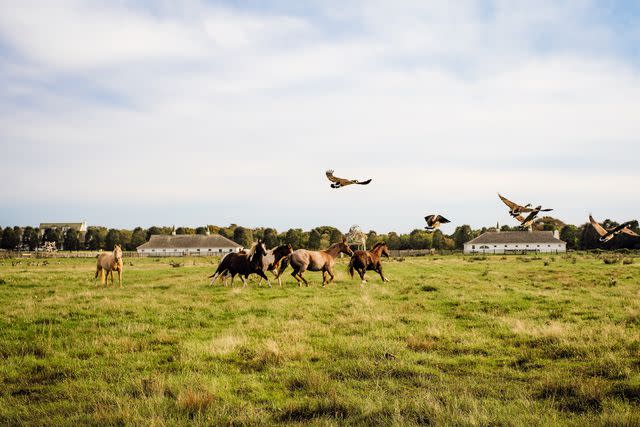
Justin Kaneps
Horses live alongside fine art at the Ranch, in Montauk, New York.In the mornings we headed to the hotel restaurant, Mostrador Marram, a casual spot that’s worth visiting even if you aren’t staying at the property. We indulged in medialunas, a kind of Argentinean croissant, and a vast array of other pastries, some with chocolate, some with cinnamon, some with honey. We indulged more than was necessary, then headed down to the beach, where we took turns watching our son and diving into the break. As the day became hotter, we retreated to the swimming pool on the hotel deck, where my son and I spent hours splashing in the water and watching the bigger kids chase each other around with water guns. As night fell, the vibe shifted. The hotel was still family-friendly (as in, s’mores by the firepit), but it also offered more grown-up experiences (private fires on the beach). We spent three blissfully content days here, thrilled by our toddler’s love for the outdoors and happy to breathe in the clean sea air.
But there was more to explore, so we packed our bags and headed a mile and half east to a friend’s house near Ditch Plains, the main surf beach. Dogs are allowed on Ditch Plains in the early morning, and my toddler was riveted by the pet procession as we waited in line for breakfast burritos at Ditch Witch. Gazing up at the tall sand cliffs, I remembered that the Montaukett people who once inhabited these lands used them as a lookout point, and I tried to imagine what this place must have been like when it was little more than grass, sand, and sea.
"This is a place where it feels as if the full moon is floating just above you, and where you can sense its gravitational force as the waves beat relentlessly against the shore. "
By 8 a.m., Ditch Plains was bustling, and we watched the surfers — some of them polished New Yorkers who pulled into the packed parking lot in Range Rovers and BMWs, others more of the barefoot variety — emerging from the water with their surfboards under their arms, greeting each other with high fives and fist bumps.
I spent the late morning visiting the shops on Montauk’s main street and chatted with Quincy Davis, a well-known surfer who opened her store, Quincy Davis, a few years ago. As I browsed silk dresses, swimsuits, and accessories, Davis told me she was planning her wedding this fall, a casual affair on the waterfront. “I was born in Montauk,” she said. “I’ve lived here my whole life, so I can’t really imagine marrying anywhere else.”
I picked up lunch next door, at Joni’s Kitchen, where Montauk native Joan Brosnan has been serving smoothies and surfer-friendly food since 2000. Then I took the family to Gin Beach, a quieter spot than Ditch Plains, where we pitched a tent on the beach. The bay water was just as cold as the ocean, but calmer and easier to swim in. My son made rock pile after rock pile. He stuffed my sandals with more rocks, then tossed them across the sand, laughing joyfully.
At sunset, I walked down the beach to Montauk County Park, passing families with folding chairs and coolers set up in front of their trailers and pickup trucks, playing classic rock from portable speakers. A dog chased a frisbee into the bay as two kids splashed around nearby. The scene reminded me of my own experiences growing up in northern California, where beach culture has always been less manicured and more accessible than it is in most of the East End.
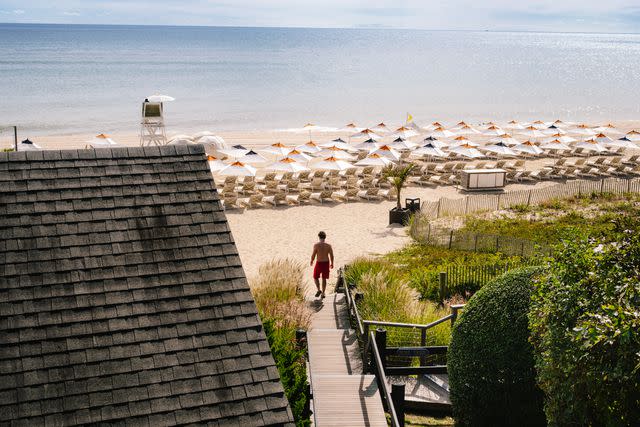
Justin Kaneps
The beach at Gurney's is one of Long Island's finest.As artists began migrating to the Hamptons during the second half of the last century, the area’s cultural cachet increased. These picturesque villages became sources of inspiration for great minds and movements, from Abstract Expressionism to Pop art. Today, not only do many artists still live out here (Julian Schnabel is perhaps the most prominent) but several galleries sell contemporary art that isn’t the typical summer offering of sailboats and sunsets.
Montauk now has two notable galleries: South Etna, which was opened by the husband-and-wife dealers Amalia Dayan and Adam Lindemann, and the Ranch, an exhibition space run by Max Levai. In 2020, Levai purchased a 26-acre Montauk horse farm up the road from Eothen, the former Warhol compound. One afternoon I stopped by to meet Levai, a fashionable type whose late father, Pierre, ran New York City’s Marlborough Fine Art gallery in the 1970s. “I came out here during the pandemic,” Levai told me. “Initially, it was a short-term plan. Then I realized I didn’t want to leave. And it just kind of made sense to show art.”
More Trip Ideas: the 15 Best Beach Resorts in the U.S.
He gestured to the vast fields around us, where horses were grazing. Levai transformed one of the two barns into a gallery and kept the other as an active stable; a third building, a more traditional Hamptons-style home where Levai lives and hosts guests, is nestled under a large oak tree. Several Frank Stella sculptures had been installed on the property for the summer. Levai, who has a relaxed but enthusiastic demeanor, explained that the exhibition space was in a moment of transition: a group show was being taken down, and the artist Jamian Juliano-Villani was due to arrive later that afternoon to discuss a new show of her paintings.
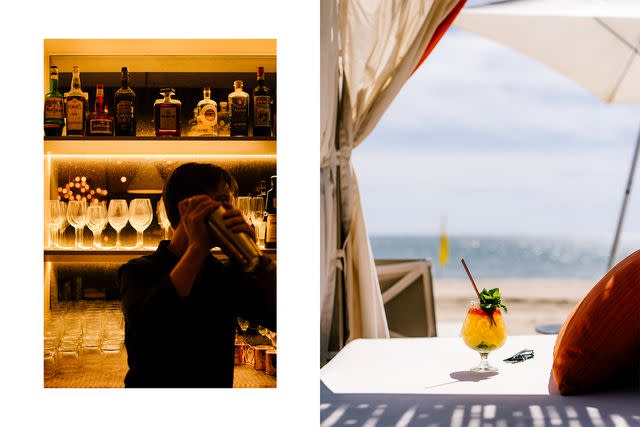
Justin Kaneps
From left: Cocktail hour at Gurney's; a cocktail by the beach at Gurney's.As Levai and I walked through the cool, empty stables, he told me about his obsession with Montauk history, and in particular, with what happened in 1926. That was the year an entrepreneur named Carl Fisher bought around 10,000 acres in hopes of creating a “Miami Beach of the North,” having made his name as the developer of the Florida city. But Fisher never got to achieve his dream: he went bust in the Great Depression and died, virtually penniless, in 1939.
We wondered what would have happened to Montauk had Fisher’s vision succeeded — and if New York’s park and highway czar, Robert Moses, hadn’t already set aside the more than 2,700 acres of land that eventually became Montauk Point State Park and Hither Hills State Park in 1924. Would Montauk’s contradictory characteristics — a wealthy, self-conscious surf destination, a solidly middle-class camping paradise, and a rarefied sliver of the already rarefied art world — have won out nonetheless? Or would they have all been leveled out to make way for something far more generic? “We’ll never know,” Levai said.
"Montauk’s appeal, for me, will always be its remoteness and its many contradictions"
I reserved the final days of our trip for Gurney’s Montauk Resort & Seawater Spa, a storied seaside inn with weather-beaten cedar shingles, pristine white trim, and an American flag that waves in the wind beside the Old Montauk Highway. Built in 1926 as a 20-room resort by a local woman, Maude Gurney, the place has grown over the years. Following a large-scale renovation in 2015, it now has 146 rooms. Richard Nixon wrote his acceptance speech for the 1968 presidential nomination here; today, celebrities like Cameron Diaz and Paul McCartney are known to swing by for dinner.
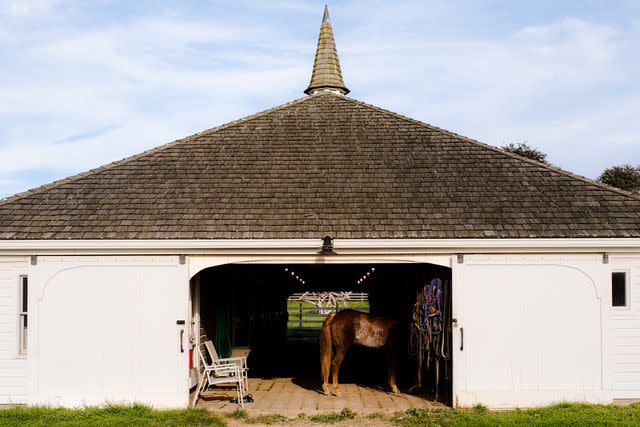
Justin Kaneps
One of the original residents of the Ranch, which also houses an ambitious art space.Gurney’s occupies one of the most glorious beaches on Long Island, and it was hard not to be swept away by its sheer size and the majesty of the view. The comfort of the hotel sucked me in, too: the staff is unfailingly attentive, and the facial I had at the Seawater Spa was sublime. In the evening, my husband and I had dinner on the deck at the resort’s Italian restaurant, Scarpetta Beach. There was something grand and glamorous about the experience, with thoughtfully composed cocktails served in heavy glasses and the night sky creating a sense of endless possibility overhead. In many ways Gurney’s stands apart from Montauk — while I was there, I felt like I was somewhere else entirely.
I didn’t mind this bit of glamour, but Montauk’s appeal, for me, will always be its remoteness and its many contradictions. I liked the fact that I walked through a horse farm littered with Frank Stella sculptures on the same day I visited a public beach where the pleasures of summer mean simply a cold beer and a jump in the bay. Montauk has never quite conformed to one idea of itself. I hope it never will.
A version of this story first appeared in the August 2023 issue of Travel + Leisure under the headline "A Haven at the End of the World."
For more Travel & Leisure news, make sure to sign up for our newsletter!
Read the original article on Travel & Leisure.

